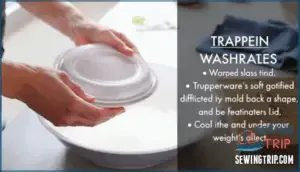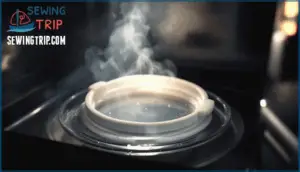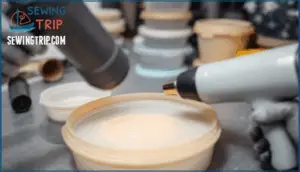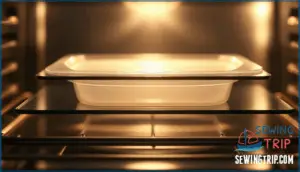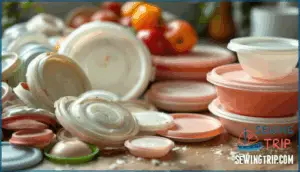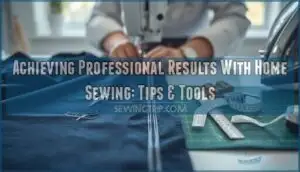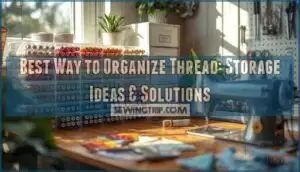This site is supported by our readers. We may earn a commission, at no cost to you, if you purchase through links.
 You pull open the cabinet, reach for your favorite container, and there it is—a Tupperware lid that looks like it spent the night in a fun house mirror. It doesn’t sit flat anymore. The seal won’t maintain. And somehow, it’s turned into a wobbly plastic Frisbee that refuses to do its one job.
You pull open the cabinet, reach for your favorite container, and there it is—a Tupperware lid that looks like it spent the night in a fun house mirror. It doesn’t sit flat anymore. The seal won’t maintain. And somehow, it’s turned into a wobbly plastic Frisbee that refuses to do its one job.
This happens more often than you’d think, usually thanks to a rogue dishwasher cycle or an unfortunate encounter with a hot pan. The good news? You don’t need to toss it. Most warped lids can bounce back to their original shape with a little heat and patience.
Let’s walk through four straightforward methods that actually work, so you can save your favorite containers and skip the replacement hunt.
Table Of Contents
Key Takeaways
- Warped Tupperware lids can be fixed using four straightforward heat-based methods: boiling water immersion, microwave steam, heat gun/hair dryer targeting, or oven heating between flat surfaces—all work by softening the plastic so you can reshape it before cooling it flat under weight.
- The main culprits behind warped lids are dishwasher heat cycles (140–160°F water plus heated dry cycles), improper storage with heavy stacking, and plastic types like polyethylene that deform at lower temperatures—hand-washing prevents most warping issues entirely.
- Successful reshaping depends on working quickly while the plastic is warm and pliable, then cooling the lid completely flat under even weight for 20–30 minutes to lock in the new shape permanently.
- Replace lids instead of repairing them if you see cracks, severe melting, brittle plastic, or deep creases that won’t flatten—Tupperware’s lifetime warranty covers manufacturing defects but excludes dishwasher damage, and replacement lids run $2–$11.50 through various retailers.
Why Do Tupperware Lids Warp?
You’ve probably opened your cabinet, grabbed a Tupperware lid, and noticed it looks like it went through a funhouse mirror. Before you can fix it, you need to understand what caused the warp in the first place.
Let’s look at the main culprits behind those bent and twisted lids.
Common Causes of Warping
Your Tupperware lid didn’t just wake up one day and decide to go rogue—warping happens when plastic gets too cozy with heat or pressure it wasn’t built to withstand. Culprits include improper stacking in cabinets, exposure to dishwasher heat cycles, material degradation over time, and even chemical exposure from harsh cleaners.
Manufacturing defects can also leave lids vulnerable to warping during everyday use, turning your DIY troubleshooting into an unexpected home improvement project.
Effects of High Heat and Dishwashers
Dishwashers are basically heat torture chambers for plastic lids—the combo of scorching water (140–160°F) and high-pressure steam pushes plastic way past its comfort zone, causing it to soften, bend, and lock into that annoying warped shape once it cools down.
Dishwashers turn plastic lids into torture victims with scorching water and steam that soften, warp, and permanently reshape them
The heated dry cycle adds insult to injury, accelerating plastic degradation and reducing heat tolerance over time. Regular dishwasher use can also trigger chemical leaching, especially when lids exceed their thermal limits.
Your best bet for warping prevention? Skip the dishwasher entirely and hand-wash lids instead—no troubleshooting or appliance repair drama required.
Types of Plastic Most at Risk
Not all plastics fare with heat the same way. Polypropylene warping is common in food containers exposed to dishwashers, though it’s more heat-resistant than polyethylene deformation, which happens at lower temperatures. Older polycarbonate lids risk BPA leaching when heated—a red flag for food safety. Acrylic cracking and polystyrene risks are even worse, as both can melt or release fumes.
Heating these plastics can also lead to chemical leaching risks, especially when microwaved.
If a lid’s broken part won’t maintain its shape after repair, it’s time for replacing dishwasher parts entirely—no appliance repair tricks can save severely damaged plastic.
How to Fix a Warped Tupperware Lid
The good news? A warped lid doesn’t have to mean it’s game over for your favorite container. With a little heat and patience, you can reshape most plastic lids back to their original form.
Here are four tried-and-true methods that actually work.
Boiling Water Immersion Method
Hot water is like a reset button for warped plastic—it softens the material just enough to coax it back into shape. Fill a bowl with water heated to around 50-60°C and submerge the lid for several minutes.
Once the lid material becomes pliable, gently manipulate the warped parts with your hands. Then cool it flat under weight—this cooling process locks in the repair without replacing dishwasher parts or buying replacement parts.
Microwave and Steam Technique
If you don’t have a microwave-safe bowl handy—or just want a faster option—steam can work wonders on a stubborn warped lid. Here’s your easy home repairs game plan:
- Place the lid in the microwave with a small cup of water beside it
- Heat for 30-45 seconds to create steam effectiveness
- Check lid pliability—it should feel warm and flexible
- Gently reshape the warped areas by hand
- Cool flat under weight to lock in your fix it yourself repair
The water quantity creates gentle heat without melting the plastic, making this an easy repair that takes under a minute.
Using a Heat Gun or Hair Dryer
When precision matters—and let’s be honest, a heat gun gives you that kind of control—you can target specific warped spots without overheating the entire lid. Set your heat gun to low (around 300°F), move it slowly over the problem area, and watch the plastic become pliable.
No heat gun? The hair dryer method works too—just takes a little longer. Temperature control is key, so keep the tool moving and never leave it in one spot.
These DIY appliance repair tools make repairing broken appliances feel like easy home repairs you can totally manage yourself.
Oven Heating Between Flat Surfaces
For stubborn warps that laugh in the face of quick fixes, the oven method brings out the big guns—slow, steady heat that reshapes your lid like new.
Here’s how to do it:
- Glass Sheet Selection and Lid Material Prep – Place your warped lid between two flat glass sheets or baking trays (skip the upper rack tools like roller wheel parts).
- Temperature Calibration and Uniform Heating – Set your oven to 150–185°F and heat for 30–45 minutes.
- Cooling Process – Remove carefully, keep the weight on top, and let it cool completely flat.
Tips for Successful Lid Reshaping
You’ve applied heat to soften the plastic—now the real magic happens in how you shape and cool it.
The difference between a lid that snaps back perfectly and one that stays wonky often comes down to a few simple tricks.
Let’s walk through what actually works when you’re hands-on with that warm plastic.
Manual Reshaping While Warm
Once the plastic’s warm and flexible, you’ve got a narrow window to work your magic before it cools and locks back into its stubborn shape. Gently press and mold the lid with your hands, focusing on problem areas. Use smooth, steady pressure rather than forcing it.
Hand-forming techniques work best when the plastic maintains pliability—think of it like working with clay. If material memory starts pulling it back, reheat briefly and try again.
Cooling Under Weight for Best Results
After you’ve shaped the lid back to life, the real secret is locking in that progress while it cools. Place the lid flat on a smooth surface and stack something heavy on top—a thick book, a cast-iron skillet, or even a few cans work great. This pressure applied keeps everything aligned as the material sets.
Key tips for cooling success:
- Weight distribution matters: Spread pressure evenly across the entire lid surface to avoid new warps or uneven spots.
- Cooling duration counts: Let it sit for at least 20–30 minutes under weight; rushing this step invites the plastic to spring back.
- Surface flatness is key: Use a completely flat base (like a countertop or cutting board) so the lid doesn’t conform to bumps or grooves.
This weighted cooling locks the shape permanently.
Avoiding Common Mistakes
Even the best technique can fall flat if you rush the heat, skip the weight, or pull the lid too soon. Overheating plastic causes melting or further warping. Uneven pressure during cooling creates new bumps. Rapid cooling doesn’t give the material time to set properly.
Ignoring cracks means you’re working with a lost cause—save your energy for replacement lids instead.
Build your self-repair confidence by taking it slow and following each step carefully.
When to Replace Instead of Repair
Sometimes, even your best reshaping efforts won’t bring a lid back to life. Before you spend more time heating and bending, it helps to know when a lid is too far gone.
Let’s look at the signs that tell you it’s time to move on—and where to find a replacement.
Signs of Irreversible Damage
Sometimes a warped lid just isn’t worth saving—and knowing when to throw in the towel can save you time and frustration. If you notice cracking along the edges, severe melting that’s changed the lid’s shape completely, or deep creases that won’t flatten, it’s time to move on.
Permanent stains, extensive damage from extreme heat, or brittle plastic are all red flags that signal the end of the line for your lid.
Tupperware Lifetime Guarantee Options
Good news—Tupperware stands behind its products with a lifetime warranty covering warping from normal use. Warranty coverage excludes damage from dishwasher heat or misuse, and replacement limits apply to discontinued items, which might get you store credit instead. Tupperware’s warranty covers manufacturing quality issues.
You can file a claim through their customer service or a consultant, though you’ll cover shipping costs and possibly a small processing fee. Processing takes 10–12 weeks, so patience pays off when self-repair confidence runs low.
Where to Find Replacement Lids
Whether repair didn’t work or you’d rather skip the hassle, replacement lids are easier to find than you think. Tupperware’s official website stocks current and some legacy lids with 3–7 day shipping.
Online marketplaces like eBay list over 11,000 options ($2–$11.50 each), while artisan platforms like Etsy offer vintage-compatible designs.
Major retailers carry universal seals for popular sizes, and warranty claims through consultants remain your backup plan for eligible damage.
Safety and Maintenance for Tupperware Lids
Once you’ve successfully reshaped your lid, you’ll want to keep it—and yourself—safe. The good news is that with a few simple habits, you can maintain your Tupperware lids for years to come.
Here’s what you need to know about safety, cleaning, and preventing future warping.
Food Safety After Heat Treatments
You’ve just applied heat to reshape your lid, but is it still safe for food? Heating plastic increases chemical migration and microplastic risks—studies show contamination levels can rise over 50% after heat exposure.
Here’s how to protect yourself:
- Inspect for visible container degradation like discoloration or brittleness before reusing
- Switch to alternative materials like glass or ceramic for safe reheating moving forward
- Avoid storing acidic or fatty foods in heat-treated lids
- Consider replacement if you’re concerned about chemical migration
- Build your self-repair confidence, but know when repair time with screwdrivers and home appliance maintenance isn’t worth health risks
Proper Cleaning and Storage Tips
Treat your Tupperware lids like the workhorses they are—a little care goes a long way toward keeping them flat and functional for years. Skip abrasive cleaners that scratch plastic and weaken seals. Use safe detergents with lukewarm water instead.
Store lids upright in lid organizers rather than stacking them under weight, which invites warping. Temperature control matters too—let hot containers cool before sealing.
Think of it as home appliance maintenance that builds your self-repair confidence without requiring screwdrivers or extended repair time.
Preventing Future Warping
Once you’ve fixed a warped lid, your best defense is keeping it away from the heat zones that bent it out of shape in the first place. Avoid dishwashers entirely—hand wash with gentle cleaning methods instead.
Store lids upright using proper stacking techniques or organizers. Choose material selection wisely when buying new containers, looking for dishwasher-safe ratings.
Correct storage prevents the self-repair cycle from repeating, saving you from needing screwdrivers or dishwasher repair down the road.
Frequently Asked Questions (FAQs)
Can you fix warped Tupperware?
Yes, you can fix warped Tupperware! Most plastic containers respond well to heat treatments. Hot water, steam, or controlled heating makes the plastic pliable again.
Success depends on plastic type and warping severity, though results vary by user experiences.
How to fix a warped plastic container?
Fixing warped plastic containers follows the same methods as lids. Hot water immersion, heat guns, oven heating, and microwave steam all work to soften the container material and restore shape, adjusting for warping severity with DIY solutions or prevention methods.
Can a warped lid regain its original flexibility?
Most warped lids bounce back after heat treatment, but plastic memory fades with age and repeated warping.
Material degradation limits flexibility, so older lids mightn’t seal as tightly even after successful reshaping.
What common household items help flatten lids?
Heavy books, flat irons, and rolling pins work great for weighing down warm lids. Hair dryers or ice packs help with heating and cooling. These household tools boost your self-repair confidence without needing screwdrivers or special parts.
Do heat-resistant gloves help during repairs?
Heat-resistant gloves protect your hands when working with hot plastic, giving you better control during reshaping. Silicone or oven mitts work great—just make sure they offer enough dexterity to press and adjust edges without losing your grip on the lid.
How to properly measure for replacement lids?
Grab a flexible measuring tape and measure your container’s top diameter in inches. Check the shape—round, square, or oval—since brand variations matter.
Look for model numbers like WD12X10327 or WD12X10304 on the base. This builds self-repair confidence fast.
Are aftermarket lids compatible with vintage containers?
Aftermarket lids rarely fit vintage containers due to size variations and design changes over decades. Seal integrity suffers without exact matches, though some sellers offer WD12X10327-style universal options.
Self-repair confidence grows when you prioritize material safety and measure carefully before buying replacements.
Can warped lids affect food freshness or storage?
A warped lid won’t seal properly, letting airflow in and speeding up food spoilage. Bacteria growth accelerates without seal integrity, reducing shelf life considerably.
Building self-repair confidence with basic fixes—or even screwdrivers for adjustments—beats tossing containers prematurely.
Do different Tupperware brands warp more easily?
Brand Warp Rates vary greatly. Manufacturing Differences and Plastic Composition impact durability—cheaper brands often use thinner materials prone to warping. Design Flaws matter too.
User Experiences show name-brand Tupperware outperforms generic alternatives, building self-repair confidence through consistent quality.
How long does the reshaping process typically take?
You’ll spend about 5–15 minutes total, depending on your heat source and warping severity. Immersion duration runs 3–10 minutes, cooling time adds another 5–10 minutes under weight—method comparison shows microwaves work fastest while building self-repair confidence!
Conclusion
A warped lid might feel like the end of the world for your food storage game, but it’s actually one of the easiest kitchen fixes you’ll ever tackle. With just heat, patience, and a flat surface, you can breathe new life into nearly any twisted plastic lid.
Now that you know how to fix a warped Tupperware lid, you’ll never look at a misshapen cover the same way again. Save the toss-out for truly lost causes—most of the time, your lid just needs a second chance to snap back into shape.
- https://www.reddit.com/r/howto/comments/1jg0iic/how_do_i_reshape_this_so_it_can_close_again/
- https://www.tiktok.com/discover/how-to-fix-warped-plastic-tupperware?lang=en
- https://www.youtube.com/watch?v=_udt9knWrM0
- https://www.cnn.com/2023/04/14/health/tupperware-safety-tips-plastic-containers-wellness
- https://pmc.ncbi.nlm.nih.gov/articles/PMC11193405/

